Welcome to the second week of “The Pull List,” where I give a quick rundown of all of the non-X comics I read this week.
My pulls this week came from a wide spread of publishers – Marvel, DC, Image, Aftershock, and Valiant! It was also a week where the minutia of the craft really took me out of enjoying the storytelling. I had a lot of bones to pick with letterers, and many comments about pace and continuity.
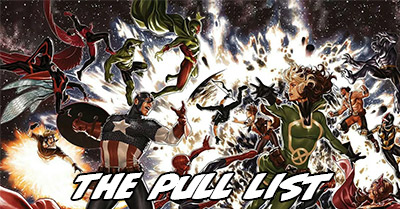
This week’s Pull List included:
- Avengers (2017) #675
- Detective Comics (1937/2016) #972
- Judas (2017) #2
- Mister Miracle (2017) #6
- Monstro Mechanica (2017) #2
- Ninjak vs. The Valiant Universe (2018) #1
- Paradiso (2017) #2
- Port of Earth (2017) #3
- Rise of the Black Panther (2018)
- Runaways (2017) #5
- Sleepless (2017) #2
- Witchblade (2017) #2
- Wonder Woman (2016) #38.
You might be surprised at which of these books I loved and which left me in a seething rage. There’s at least one where I disagree with seemingly 99% of the folks who I’ve seen react to the book in the past few days.
![]()
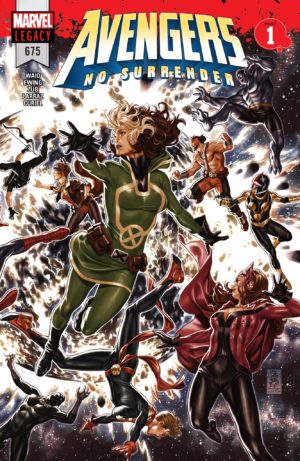 Avengers (2017) #675, Marvel Comics
Avengers (2017) #675, Marvel Comics
![]() It’s the kick-off of a huge new Avengers storyline, No Surrender, which merges the teams (both characters and creators) of all of the previously-running Avengers books for a single 16-issue story released at a breakneck weekly pace.
It’s the kick-off of a huge new Avengers storyline, No Surrender, which merges the teams (both characters and creators) of all of the previously-running Avengers books for a single 16-issue story released at a breakneck weekly pace.
I know this is a personal thing, but I get annoyed when every big superhero problem starts with every city falling apart, tidal waves, volcanoes exploding, et cetera.
It gives our heroes something to do, but then we’re meant to suddenly forget about it even though these events are likely killing millions of people around the world. Why not just make these problems more localized and containable?
I’ll never understand it, and it takes me way out of this plot of Earth being hidden in a pocket somewhere (because we totally needed more stories about Earth being collided with and stolen, especially given that we just came from a plot like this in the last arc of Avengers).
In terms of craft, it’s a strong issue. Pepe Larraz is one of Marvel’s best right now, and so is colorist David Curiel. Curiel goes for a colorful, high gloss look in this issue. It ends with a few Avengers being seemingly frozen in time to take them off the table, including Vision and Spider-Man, plus ancillary characters like the X-Men and Champions. That gives us a smaller squad to focus on for this 16-issue weekly event that leans heavily on the cast of Uncanny Avengers – and on that topic, you’ll hear no complaints from me!![]()
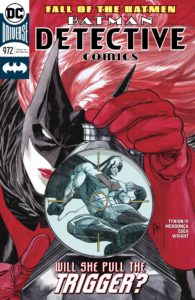 Detective Comics (1937/2016) #972, DC Comics
Detective Comics (1937/2016) #972, DC Comics
![]()
I had some misgivings about how this arc began with Tim Drake encountering a future version of himself who had taken on the mantel of Batman. As the arc has progressed, it has wound up as a sort of “Team Batman Disassembled” and I’ve been loving it. Even while the team reunites with Tim, all of their connections to each other are breaking down.
Mayor Akins: “He’s a monster, Batman.”
Batman: “So am I”
This issue really speeds things up to a conclusion as a weaponized Clayface races to confront his former teammates. In the race there are a few pages that play fast and loose with the geography of where and when everyone is assembling, but the important thing to know is that Tim thinks Batwoman ruins everything and Kate has a gun that can kill Clayface, if need be. Miguel Mendonco on pencils holds up well against Eddie Barrows on some of the surrounding issues.![]()
Judas (2017) #2, Boom! Studios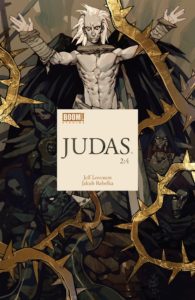
![]() This book is sacrilegious and I love it! This issue introduces Lucifer to the mix, and even if he’s grounded in scripture, his take on his legendary conflict with the king of heaven is decidedly different than what we’ve been taught – and it tracks to this series’ theme of questioning our free will.
This book is sacrilegious and I love it! This issue introduces Lucifer to the mix, and even if he’s grounded in scripture, his take on his legendary conflict with the king of heaven is decidedly different than what we’ve been taught – and it tracks to this series’ theme of questioning our free will.
My bible studies may be a bit rusty, but there is a powerful moment here for me when Judas says, “I thought [Jesus] would rise up.” This is an intriguing light to cast his betrayal – that he might have assumed that in death Jesus would finally right all the wider wrongs he had been moving within during his life. In a way he did, but now how Judas imagined it would be.
Rebelka’s pages of The Pharoah, Jezebel, and other biblical villains are gorgeous – they could be framed in a gallery. Ultimately this takes a surprising turn in the final page that sets up a story I’ve conceived of but never really thought through.
I can’t wait to read more.
![]()
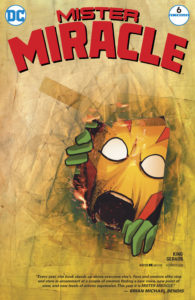 Mister Miracle (2017) #6, DC Comics
Mister Miracle (2017) #6, DC Comics
![]() I know that I’m probably the only person to break from the herd with this opinion, but after one of the best issues I read in all of 2017 on #5 I really, really hated this issue. It features a halting, repetitive script of a conversation that just barely advances, which is heavily influenced by Brian Bendis.
I know that I’m probably the only person to break from the herd with this opinion, but after one of the best issues I read in all of 2017 on #5 I really, really hated this issue. It features a halting, repetitive script of a conversation that just barely advances, which is heavily influenced by Brian Bendis.
Mitch Gerads draws the everliving hell out of the series of conflicts Miracle and Barda have while they’re chatting, but I’ve grown weary of the trope of heroes having “real” conversations while they go through rote fights. The trope is over for me. Then, the “emotional” “revelation”this one ends with is my least favorite plot device in all of comics.
In total, it’s a total cheap shot from Tom King, one of his many pendulum swings from clever to trite.
![]()
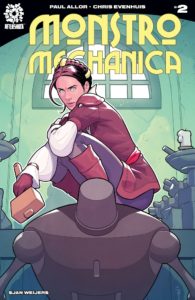 Monstro Mechanica (2017) #2, Aftershock Comics
Monstro Mechanica (2017) #2, Aftershock Comics
![]() Another truly beautiful issue of this series following Leonardo DaVinci’s assistant Isabel as she chaperones a barely-sentient automaton through a rescue mission in a city under siege by the Medicis.
Another truly beautiful issue of this series following Leonardo DaVinci’s assistant Isabel as she chaperones a barely-sentient automaton through a rescue mission in a city under siege by the Medicis.
That’s a lot to absorb, right?
This book is trying to be too many things at once. Is it a war book about loading up the canons? A book of political intrigue about whatever was delivered to the Vatican by a strange mechanical bird? A humorous buddy book of Isabel and the machine? A morality play about free will?
We get tastes of all of that, but it’s hard to understand where this is going. Part of the problem is that the book being so oblique about what the Medicis want from DaVinci aside from his aid in cracking open their long-running siege. That makes it hard to get excited about all the trading of secret messages going on behind the scenes. I think if this could manage to be a little plainer about the end-goals of the players who are controlling Isabel’s world I would love it much more.
![]()
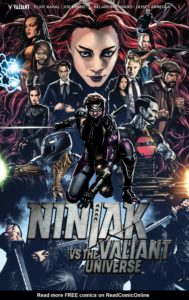 Ninjak vs. The Valiant Universe (2018) #1, Valiant Entertainment
Ninjak vs. The Valiant Universe (2018) #1, Valiant Entertainment
![]() Valiant’s publisher talks a big game about how important this comic is in his intro and they can’t even lasso his signature off a white document correctly to show it in the book, so… what I’m saying is Valiant’s proud recent history of half-assed sausage party fuckery is probably going to continue in this series.
Valiant’s publisher talks a big game about how important this comic is in his intro and they can’t even lasso his signature off a white document correctly to show it in the book, so… what I’m saying is Valiant’s proud recent history of half-assed sausage party fuckery is probably going to continue in this series.
And, hey-oh, it starts with a fight with undiscernable internal geography that leads to fridging a female ally, totally par for the Valiant course! Like, I could have predicted that, verbatim. But, they made the villain a woman, so fridgings are totally cool. Two for one fridgings!
This comic has a few nice action scenes, but they mostly feel like a series of dynamic pin-up panels rather than a unified narrative. I squinted real darn close and couldn’t make heads or tales of a lot of the physical action. Also, the plot feels so basic – you take hostage some friends of the greatest Ninja in the world, and so he is utterly compelled to break in to his (now former) employer and do evil stuff, because there’s totally no way he would be plotting any kind of subterfuge that would undermine your plan.
Between that an the utter lack of context around any character appearing here, it’s a swing and a miss on a pretty big stage for Valiant.
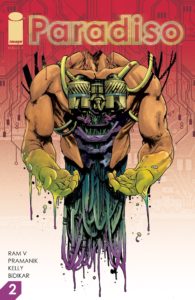 Paradiso (2017) #2, Image Comics
Paradiso (2017) #2, Image Comics
![]() This comic is a terrific example of the fact that you don’t need a ton of neat, tied-up-in-a-bow answers in a early issue to make a great comic. There is so much that doesn’t make sense here, so many missing pieces. But the definite sense is … we’ll find out. It’ll matter later. And, what does make sense so far is utterly compelling.
This comic is a terrific example of the fact that you don’t need a ton of neat, tied-up-in-a-bow answers in a early issue to make a great comic. There is so much that doesn’t make sense here, so many missing pieces. But the definite sense is … we’ll find out. It’ll matter later. And, what does make sense so far is utterly compelling.
We’re in a post-apocalyptic world where everyone wants in to a forbidden city that used to be a major world capital, but it’s rife with mercenaries who will kill you and strip you for any lit bit of technology. Enter our protagonist Jack, somewhat of an apprentice to an olden-days machinist, who carries the blueprints and knowledge to create machinery though to be long lost – plus a supernatural battery that can recharge anything.
This issue expands on the world-building we caught glimpses of in the first one, including a brief vision of the pre-apocalyptic past. That keeps us away from our main character Jack for a bit, which is a little disappointing. The art continues to be stunning, at points hard to tell where the linework ends and the colors begin.
![]()
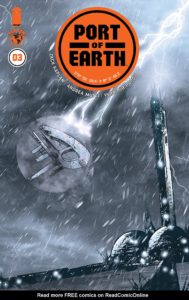 Port of Earth (2017) #3, Image Comics
Port of Earth (2017) #3, Image Comics
![]() Port of Earth has an amazing premise and a terrifically executed structure, but I’m finding myself a bit bored with its characters.
Port of Earth has an amazing premise and a terrifically executed structure, but I’m finding myself a bit bored with its characters.
This is an interesting concept, which goes from huge, wide-scope world-building about Earth being an important way-station for alien ships down to the pedestrian, with a pair of documentary cameras following a two agents whose job it is to prevent any kind of alien/human interaction.
I think the social commentary that opens each issue might be better than the ground level action that closes them. I’m just not into the aggressively hapless keystone cops. Each of them is dumb and unlikeable in their own way, and they’re both doing that while on camera. It doesn’t make a ton of sense to me, but I also know not everyone tunes out of “dumb guy causes intergalactic incident” stories the way that I do.
My other gripe with this comic is the lettering, which might be by hand? There’s a lot of variation, and it’s killing me. The font choice and tight kerning makes the words practically unreadable at points, which is not a good look for a book where the script is so important!
I might hang on for one more issue of this to see where the confrontation with a rogue alien takes us, but it’s starting to feel like a series that’s more fascinating as a Wikipedia plot summary then as an actual comic.
![]()
Rise of the Black Panther (2018) #1, Marvel Comics
![]() Do we really need more Panther origins, considering I can think of four I’ve read just from the top of my head? If this issue is any indication: YES.
Do we really need more Panther origins, considering I can think of four I’ve read just from the top of my head? If this issue is any indication: YES.
T’Challa barely appears in this fantastic comic, which focuses entirely on his father’s life as told by T’Challa’s mother – who died jsut a week after his birth. Even though we already know how this turns out, the connective tissue added by this between other stories (Flags of Our Fathers, Priest’s flashbacks and development of T’Challa’s stepmother) adds so much to Black Panther’s world.
This book helps explain the nuance of Wakanda’s isolation and the few times it was broken. It’s also gorgeous. Required reading for all Black Panther fans.
![]()
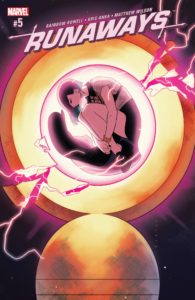 Runaways (2017) #5, Marvel Comics
Runaways (2017) #5, Marvel Comics
![]() I’ve been obsessed with the first four issues of this delightful comeback of Marvel’s favorite non-team, so this slightly uneven issue coasts a bit on my accumulated good will.
I’ve been obsessed with the first four issues of this delightful comeback of Marvel’s favorite non-team, so this slightly uneven issue coasts a bit on my accumulated good will.
This series began with four slow-burning issues, starting with just Nic sitting alone in her apartment and leading up to the team being briefly reunited around a dining table before being scattered again. Suddenly, it feels like everything happens all at once here. We get Victor waking up, the secrets of Molly’s grandma, and Karolina returning! While I was happy for the plot development, it was a bit too much coincidence for me … unless it turns out to not be a coincidence.
Matthew Wilson’s colors on the conversation between Molly and Gert in Molly’s darkened bedroom are just mindblowing. He is so good, and he elevates Kris Anka’s artwork to a level I’ve never seen from him before.
What is no so good is the lettering. I’ve noticed in the past few issues how Joe Caramanga fights to tightly kern long words into too-small bubble. This isn’t a particularly dense script and there’s plenty of room for the bubbles to get bigger, so why not expand them a pinch rather than have a weirdly tight word in each one? I don’t expect these obvious, unforced errors from Caramanga.
For the majority of readers – who don’t mind minor lettering problems and have been waiting for the plot to speed up – this will be a solid hit.
![]()
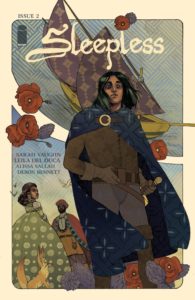 Sleepless (2017) #2, Image Comics
Sleepless (2017) #2, Image Comics
![]() Another gorgeous but slow issue of this beautiful new Leila de Luca book, with script by Sarah Vaughn.
Another gorgeous but slow issue of this beautiful new Leila de Luca book, with script by Sarah Vaughn.
I enjoy the world-building of this series, which feels adjacent to Monstress in scope. They both feel like they contain the sprawling world of a length fantasy novel. The difference is in the pace. Monstress packs in constant information, treating every dense panel like several pages worth of description, where Sleepless feels the need to spend a new panel to illustrate every little bit of dialog.
This comic spends an awful lot of time spent avoiding saying things outright when they could have just been said. Maybe “court intrigue stories” just aren’t my thing, but I spent this entire issue desperate for some kind of development or indication of plot other than our protagonists mother not returning home and her being stuck at court.
![]()
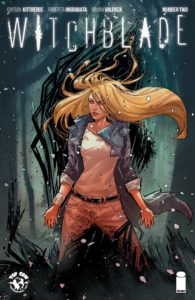 Witchblade (2017) #2, Image / Top Cow Comics
Witchblade (2017) #2, Image / Top Cow Comics
![]() Another seriously attractive issue of this new Witchblade series, made all the more impressive by the fact that it’s pretty much all just real life – no crazy superhero action to impress with.
Another seriously attractive issue of this new Witchblade series, made all the more impressive by the fact that it’s pretty much all just real life – no crazy superhero action to impress with.
I appreciate how carefully Caitlin Kittredge is setting up a revised Witchblade mythology as well as the conflict between the new carrier and a force of weirdly demonic cops. Maybe the writing isn’t the most slam-bang amazing of any comic I’ve read, but it’s solid and it’s lingering on character work, and that matters! The book can get away with it in part thanks to Noto-esque art from Roberta Ingranata.
![]()
Wonder Woman (2016) #38, DC Comics
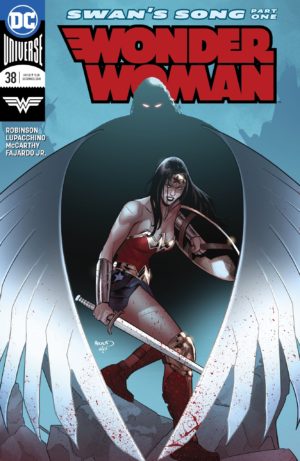
![]() I’ve been somewhat surprised by fan reaction to this series from the start, and this issue continues that trend. People loved Rucka, but I found his run to be wheel-spinning. They dismissed Shea Fontana’s brief run, but I thought it had heart. And, folks have been particularly rough on the first James Robinson arc featuring Wonder Woman’s brother, but I felt like it was the first time this book has been allowed to be an action-packed superhero comic in two years!
I’ve been somewhat surprised by fan reaction to this series from the start, and this issue continues that trend. People loved Rucka, but I found his run to be wheel-spinning. They dismissed Shea Fontana’s brief run, but I thought it had heart. And, folks have been particularly rough on the first James Robinson arc featuring Wonder Woman’s brother, but I felt like it was the first time this book has been allowed to be an action-packed superhero comic in two years!
Maybe this issue continues the trend of allowing this book to be kinetic and super-heroic, but I cannot see that past my annoyance with the perversion of classic George Perez continuity. Part of the magic of Rucka’s reintroduction of Diana in his opening arc is that he revised her history without directly contradicting any of Perez’s definitive 1987 version of events. I thought that was the whole point of DC Rebirth – reconciling the old with the new.
Yet, this issue mashed up a pair of George Perez’s most enduring characters into one annoyingly flat new version of Silver Swan. The original Silver Swan was a fascinating counter-point to Wonder Woman’s specific brand of feminism. She was a sort of fake-feminist symbol controlled by men who could also be seen as an in-story allegory for Wonder Woman as a feminist icon as created and written almost exclusively by men. A later transformation of Vanessa Kapatelis into a second Swan capitalized on over a decade of Vanessa living out her simple, human life in Diana’s shadow – a perfect extension of the original themes of the Swan.
This issue tries to do all of that in about ten pages. That’s not only a disastrous storytelling choice, but it also really confuses what we know about Wonder Woman’s continuity. Granted, I’m not up on Wonder Woman of the 00s, but this effectively rules out 200 entire issues of Post-Crisis comics from ever having happened. It’s especially a weird choice because Silver Swan didn’t really need a new origin – she’s a a villain could fairly have been assumed to already exist somewhere in the margins of Wonder Woman’s revised history.
There’s also Diana’s schoolmarmish admonishing of her brother Jason (which, even if it rings true, isn’t a good look for this book) and some truly horrible lettering from Saida Temofonte.